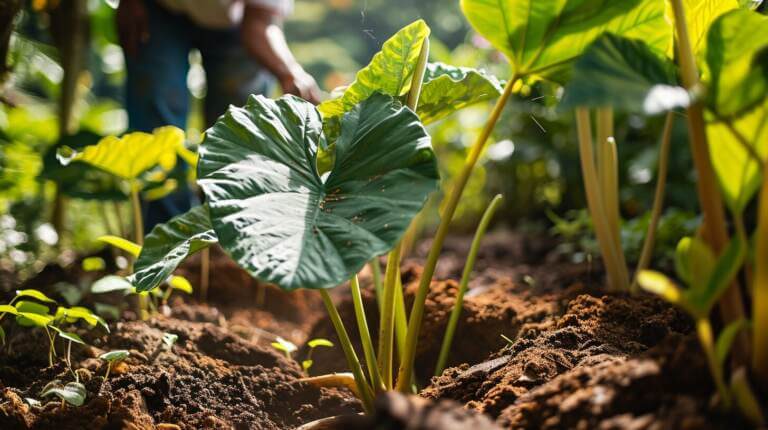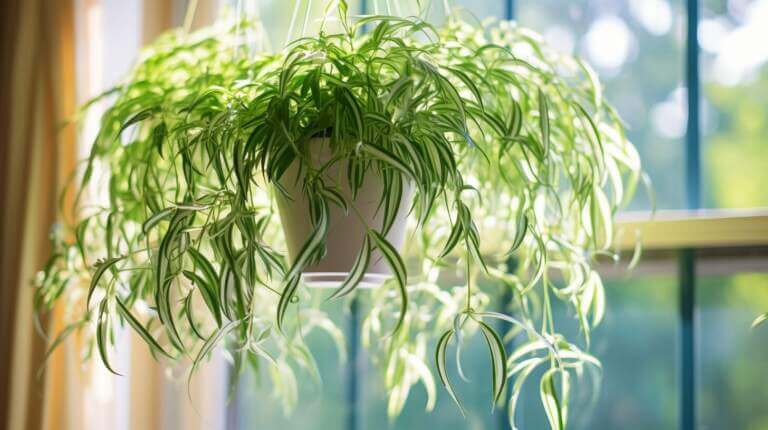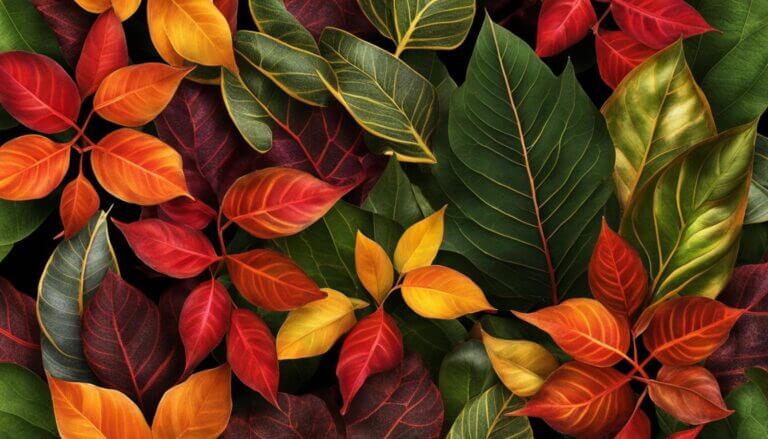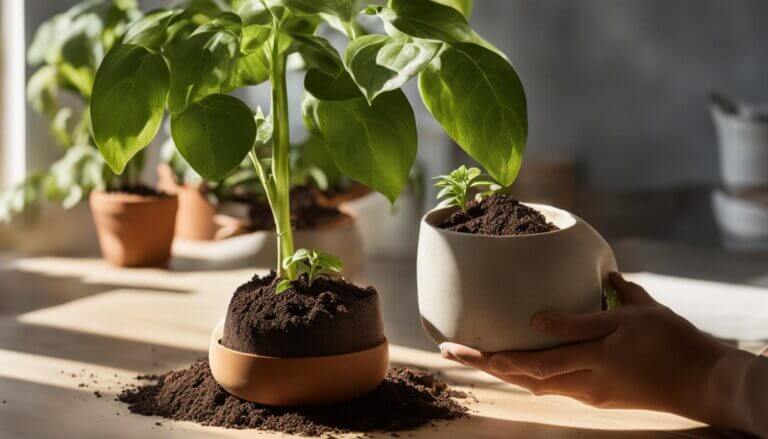Why Are Your Dumb Cane Leaves Turning Yellow? Common Causes and Fixes For Dieffenbachia Yellow Leaves
If you’ve noticed your Dieffenbachia leaves turning yellow, don’t worry – you’re not alone. This common issue can be caused by a variety of factors, from overwatering to inadequate lighting. Understanding the specific causes and implementing the right fixes is key to restoring your Dieffenbachia’s vibrant green color.
Key Takeaways:
- Overwatering can lead to root rot and yellow leaves. Proper drainage and monitoring watering frequency are crucial.
- Inadequate lighting, both direct and indirect, can cause Dieffenbachia leaves to turn yellow. Provide bright indirect light for optimal growth.
- Nutrient deficiencies, particularly a lack of nitrogen, can impact leaf color. Regular fertilization is important.
- Underwatering can cause dehydration and yellowing of the leaves. Monitor soil moisture and adjust watering accordingly.
- Pest infestations, such as spider mites and mealybugs, can contribute to yellowing leaves. Regular monitoring and appropriate pest control measures are necessary.
- Yellowing leaves may also be part of the plant’s natural life cycle. Trimming old leaves can redirect energy towards new growth.
Overwatering: A Common Cause of Dieffenbachia Yellow Leaves
Overwatering is one of the most common causes of Dieffenbachia leaves turning yellow. When the plant receives excess water, it can lead to root rot and hinder the plant’s ability to absorb essential nutrients. The roots become mushy and are unable to efficiently transport water and nutrients to the rest of the plant. To prevent overwatering, it is important to strike a balance with the amount of water the Dieffenbachia plant receives.
Proper drainage is crucial to prevent overwatering. Ensure that the pot has drainage holes at the bottom to allow excess water to escape. Additionally, use a well-draining potting mix that promotes water flow and prevents water from sitting around the roots for too long. Regularly check the soil moisture level before watering and adjust accordingly. Avoid watering the plant if the top inch of the soil feels damp to the touch.
Table: Signs of Overwatering in Dieffenbachia Plants
| Signs | Description |
|---|---|
| Yellowing leaves | Excessive water can cause the leaves to turn yellow. |
| Mushy roots | Overwatering can lead to root rot, resulting in mushy roots. |
| Persistent dampness | The soil remains consistently damp, even after a watering cycle. |
| Poor growth | The plant may exhibit stunted growth or fail to produce new leaves. |
Inadequate Lighting: A Culprit Behind Dieffenbachia Yellowing
Inadequate lighting can be a significant factor contributing to Dieffenbachia leaves turning yellow. While these plants can tolerate lower lighting conditions, they thrive in bright indirect light. Placing the plant near an east-facing window or a few feet away from an unobstructed southern or western window can provide the optimal light levels. However, it’s essential to strike the right balance and avoid exposing the plant to too much direct sunlight, as this can also result in yellowing leaves.
When Dieffenbachia does not receive enough indirect bright light, the leaves may start to turn yellow. This is because insufficient light can hinder the plant’s ability to carry out photosynthesis effectively. Photosynthesis is the process through which plants convert light energy into food, and when this process is compromised, it can lead to leaf discoloration.
The Importance of New Growth
New growth is a vital sign of a healthy Dieffenbachia plant. When the plant receives enough indirect light, it can produce new leaves that are vibrant green in color. These new growths replace the older leaves, which may naturally turn yellow and drop off. However, if the plant consistently produces yellowing leaves and fails to generate new growth, it may indicate a more severe underlying issue.
“Proper lighting is crucial for Dieffenbachia plants to thrive and maintain their green color. By ensuring the plant receives enough bright indirect light, you can help prevent yellowing leaves and promote healthy new growth.” – Plant Expert
Summary
Inadequate lighting, particularly a lack of indirect bright light, can cause Dieffenbachia leaves to turn yellow. The plant requires sufficient light to carry out photosynthesis and maintain its vibrant green color. Placing the plant near a suitable window or using artificial grow lights can help address this issue. Monitoring the plant’s light requirements and promoting new growth are essential for a thriving and healthy Dieffenbachia plant.
| Causes of Dieffenbachia Yellowing | Fixes |
|---|---|
| Inadequate lighting, lack of indirect bright light | Relocate the plant to a spot with better lighting conditions or supplement natural light with artificial grow lights |
| Insufficient photosynthesis due to lack of light | Ensure the plant receives enough indirect bright light for proper photosynthesis |
| Lack of new growth | Monitor the plant’s health and address any underlying issues preventing new growth |
Nutrient Deficiencies: Impact on Dieffenbachia Leaves
Nutrient deficiencies can play a significant role in causing Dieffenbachia leaves to turn yellow. When the plant lacks essential nutrients, such as nitrogen, it struggles to maintain its vibrant green color and healthy foliage. Understanding the impact of nutrient deficiencies and implementing proper feeding practices can help keep your Dieffenbachia plant thriving.
One common symptom of nutrient deficiencies in Dieffenbachia plants is yellowing leaves. These yellowed leaves may also exhibit stunted growth or develop brown tips, indicating a lack of essential nutrients. Regular fertilization with a diluted houseplant fertilizer can help replenish the necessary nutrients and promote healthy leaf growth. It is best to follow the specific fertilizer recommendations for Dieffenbachia plants, as overfertilization can lead to other issues, such as salt buildup.
When applying fertilizer to your Dieffenbachia, it is important to follow the instructions carefully to prevent overfeeding. It is generally recommended to fertilize the plant every month during the growing season, which typically occurs in spring and summer. However, it’s crucial to monitor the plant’s response to the fertilizer and adjust the feeding frequency or strength accordingly. Always remember to water the plant before applying fertilizer to avoid causing stress to the roots.
Key Points:
- Nutrient deficiencies can cause Dieffenbachia leaves to turn yellow.
- Yellowing leaves, stunted growth, and brown tips are common symptoms.
- Regular fertilization with a diluted houseplant fertilizer can prevent nutrient deficiencies.
- Follow specific fertilizer recommendations and adjust feeding frequency as needed.
Table: Common Nutrient Deficiencies and Their Effects on Dieffenbachia Leaves
| Nutrient Deficiency | Effect on Dieffenbachia Leaves |
|---|---|
| Nitrogen | Yellowing leaves, stunted growth |
| Phosphorus | Purple or dark-colored leaves, reduced growth |
| Potassium | Yellow or brown leaf margins, weak stems |
| Iron | Yellowing between veins, leaf discoloration |
Underwatering: Another Trigger for Dieffenbachia Yellow Leaves
Underwatering is a common cause of Dieffenbachia leaves turning yellow. When the plant doesn’t receive enough water, it can become dehydrated, leading to leaf yellowing. Ensuring proper hydration is crucial to maintain the health and vibrancy of your Dieffenbachia plant.
Dieffenbachia plants have moderate water needs. They prefer to be kept evenly moist but not waterlogged. Insufficient watering can cause stress to the plant, resulting in yellowing leaves. To avoid this, it’s important to water your Dieffenbachia when the top 50-75% of the soil is dry. This allows the plant’s roots to absorb water and nutrients properly.
Regular monitoring of soil moisture is key to preventing underwatering. You can use your fingers or a moisture meter to check the moisture level of the soil. If the soil feels dry, it’s time to water the plant. Remember to water thoroughly, allowing excess water to drain from the pot. Avoid letting the plant sit in standing water, as it can lead to root rot.
Signs of Underwatering:
- Leaves turning yellow
- Soil is dry
- Wilting or drooping foliage
- Leaf edges curling or browning
In addition to regular watering, it’s also important to provide proper humidity for your Dieffenbachia plant. These tropical plants thrive in environments with higher humidity levels. You can increase humidity by misting the leaves with water, placing the plant on a tray filled with water and pebbles, or using a humidifier.
| Signs of Underwatering | Remedies |
|---|---|
| Leaves turning yellow | Water the plant when the top 50-75% of the soil is dry. |
| Soil is dry | Monitor soil moisture regularly and water when dry. |
| Wilting or drooping foliage | Ensure thorough watering to hydrate the root system properly. |
| Leaf edges curling or browning | Provide proper humidity through misting, trays of water, or humidifiers. |
Pest Infestations: Contributing Factor to Dieffenbachia Yellowing
Pest infestations can be a significant cause of Dieffenbachia leaves turning yellow. Common pests that affect Dieffenbachia plants include spider mites, sap-sucking bugs like mealybugs, and scale insects. These pests feed on the plant’s sap, causing damage to the foliage and leading to yellowing and discoloration of the leaves. It’s essential to identify and address pest infestations promptly to protect the health of your Dieffenbachia plant.
Spider mites are tiny arachnids that thrive in warm and dry conditions. They often appear as tiny red or brown dots on the undersides of the leaves. These pests pierce the plant’s cells and suck out the sap, causing leaves to turn yellow and eventually die. Mealybugs are soft-bodied insects that leave behind a cotton-like residue on the plant. They, too, feed on the plant’s sap, leading to yellowing and wilting of the leaves. Scale insects attach themselves to the stems and leaves of the plant, draining it of vital nutrients and causing yellow discoloration.
To combat pest infestations, regularly inspect your Dieffenbachia plant for any signs of pests. If you notice any pests or their presence, you can use organic pest control methods such as neem oil or insecticidal soap. These products are effective in controlling and eliminating pests while minimizing harm to the plant and the environment. It’s important to follow the instructions provided on the product label and apply the treatment as directed.
| Pest | Description | Control Measures |
|---|---|---|
| Spider Mites | Tiny arachnids that suck sap | – Regularly check the undersides of leaves for tiny red or brown dots – Use a magnifying glass to spot the pests – Apply neem oil or insecticidal soap – Increase humidity to deter mites |
| Mealybugs | Soft-bodied insects that leave cotton-like residue | – Inspect plant for fluffy white residue – Use a cotton swab dipped in rubbing alcohol to remove mealybugs – Apply neem oil or insecticidal soap |
| Scale Insects | Small, immobile insects that attach to stems and leaves | – Physically remove scales with a cotton swab dipped in rubbing alcohol – Apply neem oil or insecticidal soap – Prune heavily infested parts of the plant |
Natural Life Cycle: Shedding Old Leaves
As part of the natural life cycle of Dieffenbachia plants, it is normal for them to shed their older leaves. If you notice yellowing leaves, especially at the bottom of the plant, it could be a natural process where the plant redirects its energy towards new growth. Trimming off the old leaves can help the plant focus its energy on producing fresh and healthy foliage.
Dieffenbachia plants prioritize new growth and often allocate resources to developing new leaves. During this process, older leaves may turn yellow and drop off to make room for the new leaves. It’s essential to understand that this is a normal occurrence and not necessarily indicative of a problem with your plant.
When trimming the older leaves, it is important to use clean and sharp pruning shears. Cut the leaves close to the base of the stem, making a clean cut to avoid damaging the plant. By removing the older leaves, you encourage the plant to channel its energy towards new leaf production and overall growth.
By familiarizing yourself with the natural life cycle of Dieffenbachia plants and providing appropriate care, you can ensure a thriving plant with vibrant green leaves. Remember that trimming old leaves is a normal part of the plant’s growth process and can help redirect its energy towards new growth.
FAQ
Why do the leaves on my Dieffenbachia turn yellow?
Dieffenbachia leaves can turn yellow due to several reasons. Overwatering or underwatering your plant, lack of proper sunlight, or a nutrient deficiency can cause yellow leaves. It’s important to assess the care you’re providing to your indoor plant and adjust as necessary.
What causes yellow leaves on a Dumb Cane plant?
Yellow leaves on a Dumb Cane plant can be caused by improper watering, lack of sunlight, or a nutrient deficiency. If the lower leaves are turning yellow, it might be a natural process of aging. However, if many leaves or the upper leaves are turning yellow, it might indicate a problem with the plant’s care.
How can I fix the yellow leaves on my Dieffenbachia?
To fix yellow leaves on your Dieffenbachia, first identify the cause of the yellowing. Adjust your watering schedule, ensure the plant is getting the right amount of light, and consider repotting the plant with fresh soil. If the yellowing continues, consult with a local nursery or extension service.
Is it normal for Dieffenbachia leaves to turn yellow?
While it’s normal for the lower leaves of a Dieffenbachia to turn yellow and drop off as the plant ages, yellowing of many leaves or the upper leaves can indicate a problem such as overwatering, poor lighting, or a nutrient deficiency.







